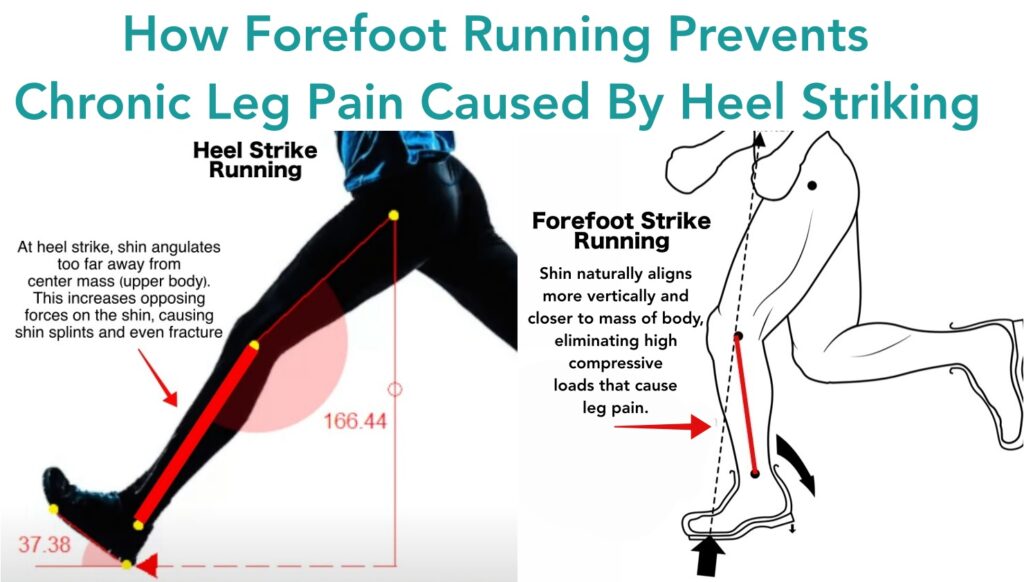Mounting research over the last decade reveals that forefoot running does a better job at preventing injury than heel strike running.


For instance, by impact standards, forefoot running was found to directly facilitate key mechanical outputs that server as a constant source of impact and repetitive strain protection. This is why forefoot runners can run barefoot or in barefoot-like running shoes with minimal risk of impact-related injury.
Below is a list of the injuries common in heel strike running but are greatly improved, if not fully resolved with forefoot running!
Patellofemoral Joint Stress (aka runners knee)
The most common injury forefoot running is well on record for preventing is runner knee (also known as patellofemoral joint stress). This is because landing forefoot-first when running was repeatedly shown to significantly reduce the patellofemoral kinetics that cause patellofemoral pain in heel strike runners! More on this here!
Hip Pain
Forefoot running was found to engage key stride parameters and improve the upper body’s postural trajectory at touchdown all of which led to significant reductions in loading and impact on the hips. More on this here!
Anterior Shin Splints
Forefoot running, especially at faster running speeds, may reduce the risk of shin splints by preventing fatiguing muscle activity in the shins as compared with heel strike running. Read more here!
Tibial (Shin) Shock
In keeping with unburdening the shins, forefoot running may also reduce the risk of shin fracture by improving the positioning of the shin at touchdown. This was found to significantly reduce opposing forces on the lower leg as compared with heel strike running. Read more here!
Medial Calf Pain
At touchdown in forefoot running, the calf muscle doesn’t forcibly stretch in the way that it does at touchdown in heel strike running. This is one reason the calves may endure less strain and injury proneness in forefoot running. Read more here!
Tarsal Tunnel Syndrome
In forefoot running, there’s less burst of high impact which in turn may prevent compartment pressure in the lower leg from rising to pain-inducing, nerve-compressing levels as compared with heel strike running. Read more here!
Lower Back Pain
Landing with a heel strike when running was found to increase knee extension (unbending of the knee) at landing which increased the over-stride angle. This means the foot landed too far ahead of the upper body. In consequence, this altered the position of the lower back, resulting in lumbar lordosis. Conversely, since landing forefoot-first when running reduces knee extension and therefore reduces over-striding may keep the lower back in a more neatural and may reduce off the area. Read more here!
The biggest takeaway is that forefoot running continues to build an impressive record of success in preventing many of the injuries that plaque heel strike runners. This is why forefoot running may help you adapt quickly and safely to harder training, which may profoundly improve your performance as well!
If you’ve enjoyed this article, you’ll love my content over at my YouTube channel, here, where I go into more detail about the evidenced-based facts on the performance and injury preventative advantages of forefoot running vs heel strike running.
If you’d like, you can support Run Forefoot and help keep it going by making a donation in any amount of your choosing:

Or, you can support Run Forefoot by shopping at the BEST Barefoot Shoe Brands, and be sure to bookmark these links 🙂
Lonowear: https://lonowear.com/?ref=cedsholh
Saguaro: https://www.saguaro.com/?ref=9bVA8fEkmDvB-I
Vibram FiveFingers: https://www.anrdoezrs.net/click-7600968-11372648
Vivobarefoot: https://amzn.to/3vycQOY
Be Lenka: https://www.tkqlhce.com/click-7600968-13947200
Xero Shoes: https://xeroshoes.com/go/Run_Forefoot
Iguaneye: https://www.iguaneye.com/?ref=8tfXVc92
Soft Star Shoes: https://shrsl.com/3mp1b
Wilding Shoes: https://bit.ly/3lIygQP
Bretta Riches
BSc Neurobiology; MSc Biomechanics candidate, ultra minimalist runner & founder of RunForefoot. I was a heel striker, always injured. I was inspired by the great Tirunesh Dibaba to try forefoot running. Now, I'm injury free. This is why I launched Run Forefoot, to advocate the health & performance benefits of forefoot running and to raise awareness on the dangers of heel striking, because the world needs to know.
Latest posts by Bretta Riches (see all)
- Can You Run In Barefoot Shoes? Yes, But DON’T Heel Strike! - 21/07/2024
- Why Cushioned Running Shoes Are Really Bad for Your Feet - 19/07/2024
- Do Cushioned Running Shoes Cause Injuries? - 17/07/2024

